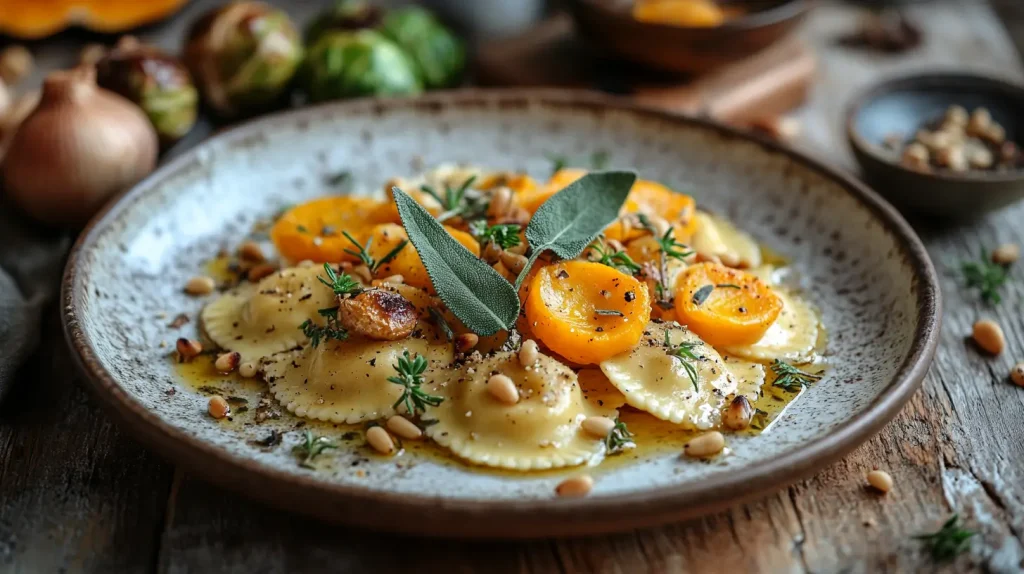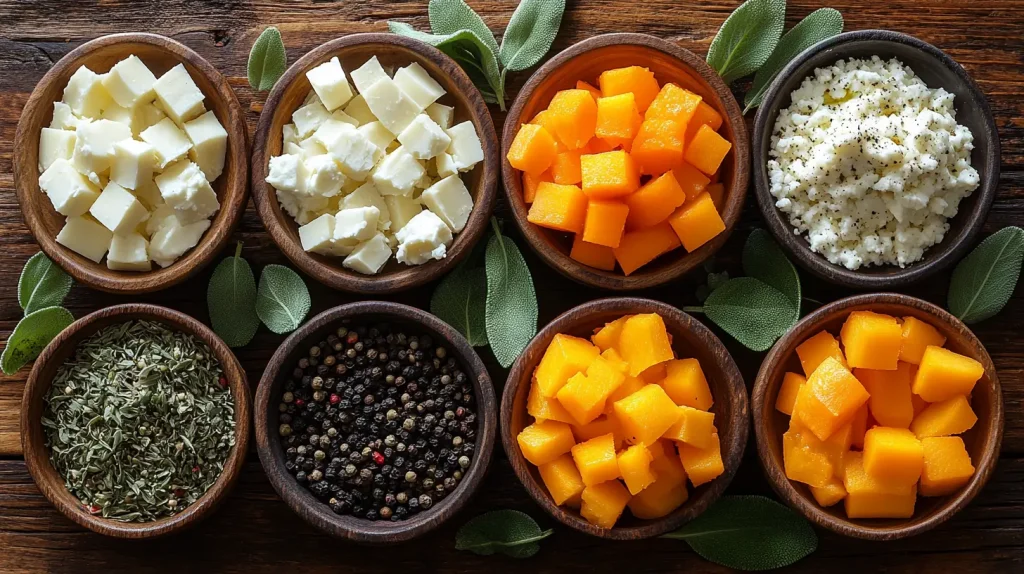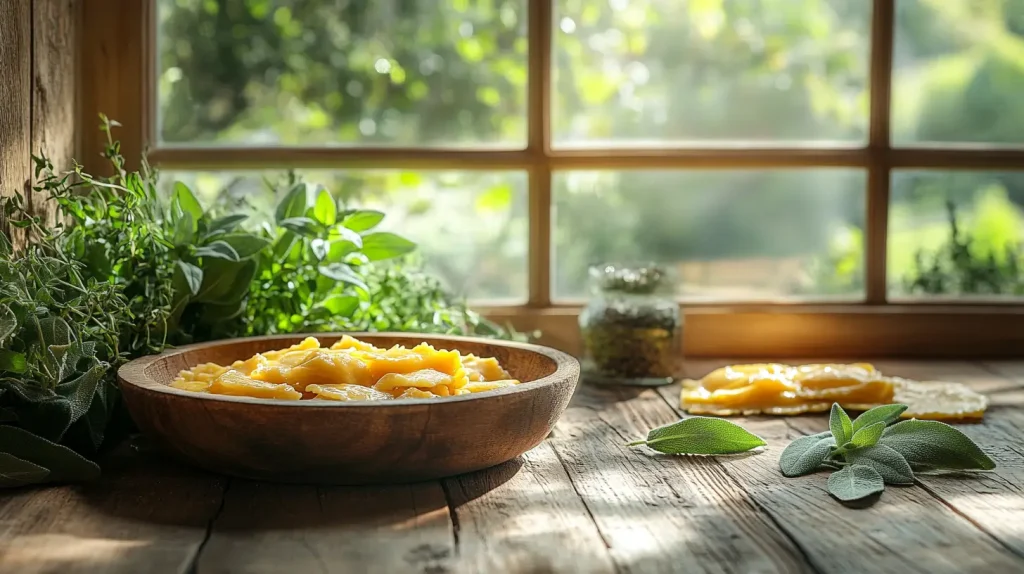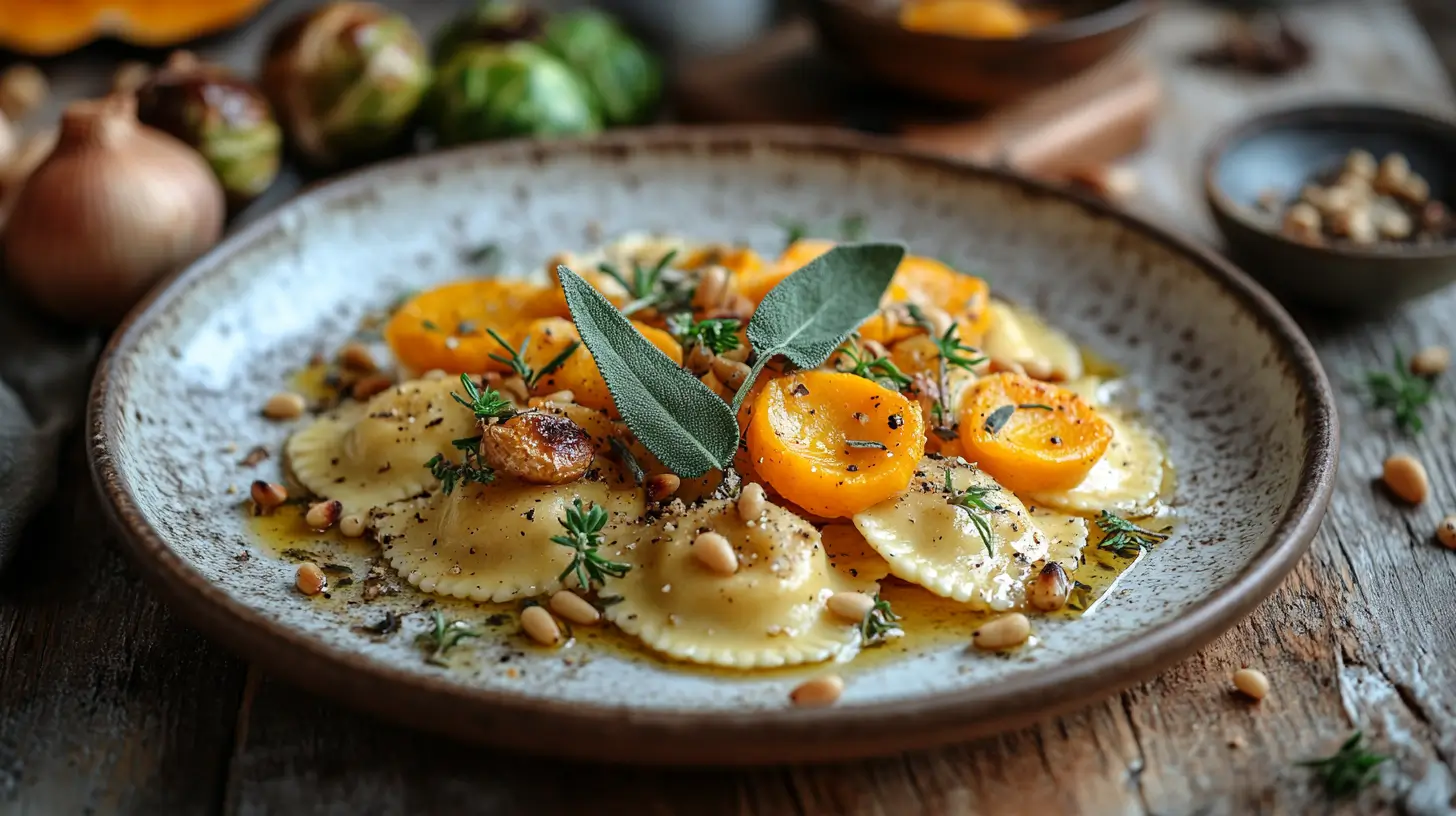My journey with butternut squash ravioli sauce started on a cool autumn night. I discovered the magic of the perfect sauce, which turned a simple dinner into a feast of flavors and textures.
Making the perfect butternut squash ravioli sauce is like art. It mixes seasonal ingredients, flavors, and technique. The right sauce can make a simple dish unforgettable, highlighting the squash’s sweetness and savory taste.
Whether you cook at home or love food, knowing about squash ravioli pairings is key. Each sauce has its own story, blending seasonal flavors and creativity.
Key Takeaways
- Sauce selection dramatically impacts the overall flavor of butternut squash ravioli
- Seasonal ingredients play a critical role in sauce development
- Brown butter sage sauce is a classic choice for butternut squash ravioli
- Trying new sauce techniques can improve your cooking
- Finding the right balance between sauce and filling is essential
Basics of Butternut Squash Ravioli Sauce Pairings
Making the perfect ravioli sauce is all about finding the right mix of flavors, much like the importance of balancing ingredients in Gluten Free Ravioli to create a satisfying meal. It’s important to know the traditional Italian sauce components. When you pick the right sauce for butternut squash ravioli, it can turn a simple meal into a work of art.
Traditional Components for the Perfect Butternut Squash Ravioli Sauce
Italian sauces are built on a few key ingredients. These ingredients make every meal special. My top picks include:
- Extra virgin olive oil
- Fresh garlic
- High-quality herbs like basil and oregano
- Aged Parmigiano-Reggiano cheese
- Fresh cracked black pepper
Complementary Flavors for Squash Ravioli Sauce
Complementary flavors are essential in ravioli sauce pairings. For butternut squash ravioli, look for sauces that balance its sweetness with savory notes.
“The secret to an exceptional sauce lies in understanding how flavors interact and complement each other.” – Italian Culinary Tradition
Seasonal Considerations for Sauce Selection
The type of sauce you choose changes with the seasons. In fall and winter, rich cream-based or brown butter sauces are perfect. But in summer, go for lighter, herb-infused sauces that show off fresh ingredients.

When picking a sauce for your ravioli, remember to keep things balanced. Your sauce should add to the pasta’s flavor, not take over.
Essential Ingredients for Butternut Squash Ravioli Sauce
Making a great butternut squash ravioli sauce needs the right ingredients. Quality and balance are important. They make the sauce perfect.

- Butter: Use ½ cup of high-quality salted butter for rich flavor
- Fresh sage leaves (approximately 20 mid-sized leaves)
- Freshly grated Parmesan cheese
- Reserved pasta cooking water
Choosing the best ingredients makes a big difference. The pasta water makes the sauce smooth. Fresh sage adds a great smell that goes well with the squash, just as the buttery flavor of Ritz Cracker Cookies complements both sweet and savory dishes.
“The secret to an extraordinary sauce is using fresh, high-quality ingredients with intention and care.”
This sauce is not only tasty but also good for you. Butternut squash is full of health benefits. It can help your heart and help you stay at a healthy weight.
| Nutritional Breakdown | Per Serving |
|---|---|
| Calories | 170 kcal |
| Protein | 9g |
| Carbohydrates | 37g |
Pro tip: You can keep this sauce in the fridge for up to 3 days. Or freeze it for 3 months. It makes cooking easier and more flexible.
Classic Brown Butter Sage Sauce Recipe
Making the perfect brown butter sage sauce turns butternut squash ravioli into a true masterpiece. My recipe will show you how to make a rich sauce. It will make your pasta dish unforgettable.
Preparing the Perfect Brown Butter
To start, you need to prepare the butter carefully. Choose high-quality unsalted butter for the best taste. Remember, patience and careful heat control are key.
- Use a light-colored skillet for accurate color monitoring
- Melt butter over medium-low heat
- Stir continuously to prevent burning
- Watch for golden-brown color and nutty aroma
Fresh Sage Integration Techniques
Fresh sage makes the brown butter sauce smell amazing. It’s important to add the sage leaves at the right time to avoid burning.

“The secret to an exceptional creamy sage butter sauce lies in the quality of your ingredients and technique.” – Chef’s Wisdom
Finishing Touches and Garnishes
Add garnishes that match the ravioli’s flavors to enhance your sauce. This will make your dish even more special.
| Garnish | Flavor Profile | Recommended Quantity |
|---|---|---|
| Toasted Pine Nuts | Nutty, Earthy | 2 tablespoons |
| Grated Parmesan | Sharp, Salty | 1/4 cup |
| Cracked Black Pepper | Spicy, Warm | To taste |
The creamy sage butter sauce is rich. It has about 783 calories per serving. It has 59g of fat and 20g of protein. This sauce is a perfect match for butternut squash ravioli, adding flavor and indulgence.
Creamy Sauce Variations for Butternut Squash Ravioli
Making the perfect creamy ravioli sauce turns a simple dish into a masterpiece. Butternut squash ravioli needs a sauce that matches its sweet taste. It should also add a smooth, rich texture.
Exploring alfredo sauce for ravioli, I found some great variations. They make the meal even better:
- Classic Cream Alfredo: Mixes heavy cream, parmesan, and butter
- Goat Cheese Cream Sauce: It’s tangy and smooth
- Pumpkin Cream Sauce: It’s seasonal and rich
- Nutmeg-Infused White Sauce: Adds warmth and depth
For a sublime creamy ravioli sauce, you’ll need:
- 2 cups chicken stock
- 1/4 cup heavy cream
- 1 teaspoon dried sage
- 1/2 teaspoon nutmeg
“The secret to an exceptional sauce lies in balancing richness with subtle herbaceous notes.” – Culinary Expert
My top tip is to slowly reduce the cream. This makes the sauce thick and sticks well to the ravioli. Try different herbs and spices to make your own special sauce.
Wine-Based and Light Sauce Options
Making the perfect sauce for butternut squash ravioli is all about balance. Light pasta sauces bring out the squash’s sweetness. This makes the dish a true delight for your taste buds.
White Wine Reduction Techniques
A wine-based sauce can turn a simple dish into a masterpiece. Choose a crisp white wine like Pinot Grigio or Sauvignon Blanc. This makes a light, elegant sauce.
The reduction process makes the wine’s flavors stronger, similar to how the slow melting of chocolate in Chocolate Chip Cookies enhances their richness. This creates a rich coating for your ravioli.
- Select a high-quality dry white wine
- Reduce wine over medium heat until volume decreases by half
- Add butter for richness and smooth texture
Herb-Infused Light Sauces
Fresh herbs can really boost light pasta sauces. Thyme, basil, and parsley are great with butternut squash ravioli. They add depth and complexity.
| Herb | Flavor Profile | Recommended Pairing |
|---|---|---|
| Thyme | Earthy, slightly minty | Butternut squash ravioli |
| Basil | Sweet, peppery | Light cream-based sauces |
| Parsley | Fresh, bright | Wine-based reduction sauces |
Balancing Acidity and Sweetness
The secret to a great light pasta sauce is balancing acidity and sweetness. A bit of lemon juice can brighten a wine-based sauce. A little honey can soften the sharp notes.
“The perfect sauce is like a culinary symphony – each ingredient plays a key role in harmony.” – Chef Marco Rossi
Tips for Sauce Consistency and Temperature
Mastering pasta sauce consistency is an art. It can make your butternut squash ravioli go from good to great. Understanding the balance of texture and warmth is key for a memorable meal.
To get the perfect ravioli sauce temperature, pay close attention. Here are some important tips:
- Use pasta water to adjust sauce consistency – a pro’s secret
- Go for a silky texture that sticks to ravioli
- Keep the sauce warm but not boiling to keep flavors fresh
“The right sauce consistency transforms a simple dish into a culinary masterpiece.”
Here are some ways to manage pasta sauce consistency:
- Slowly reduce sauce to thicken it naturally
- Add small amounts of pasta water to thin it if needed
- Stir constantly to avoid separation
For the best ravioli sauce temperature, serve it right after making it. The sauce should be warm enough to release herbs but not too hot. Aim for 160-175°F for the perfect serving temperature.
Pro tip: If you need to reheat, use low heat and stir often. This keeps the sauce’s original consistency and prevents burning.
Seasonal Ingredients to Enhance Your Sauce
Making great seasonal ravioli sauces is like art. It turns butternut squash pairings into something amazing. The secret is using fresh, lively ingredients that match the squash’s rich taste all year.
Fall and Winter Culinary Delights
In the cold months, add strong seasonal ingredients to your sauce. They add warmth and depth. Here are some tasty choices:
- Roasted chestnuts for a nutty crunch
- Crispy pancetta for savory richness
- Caramelized onions for sweet complexity
- Dried cranberries for a touch of tartness
Spring and Summer Sauce Variations
For warmer months, go for lighter sauces. My top picks for spring and summer include:
- Fresh peas for vibrant green color
- Lemon zest for bright acidity
- Sun-dried tomatoes for intense flavor
- Fresh basil leaves for aromatic freshness
“The secret to an exceptional sauce is using locally sourced, seasonal ingredients that tell a story on your plate.”
Using seasonal ingredients makes your butternut squash ravioli sauces unforgettable. They delight your senses and celebrate each season’s unique flavors.
Common Sauce Pairing Mistakes to Avoid
When making butternut squash ravioli, picking the right sauce is hard. Some mistakes can ruin a dish that could be amazing.
It’s important to pair pasta well to make a good dish. Here are some mistakes to avoid:
- Overwhelming the delicate squash flavor with intense sauces
- Using overly heavy cream-based preparations
- Neglecting seasoning balance
- Ignoring temperature considerations
The biggest mistake is choosing a sauce that fights the squash’s sweetness. Subtle complementary flavors work best.
“Sauce should enhance, not overpower the ravioli’s essence.”
| Mistake | Recommended Solution |
|---|---|
| Heavy cream sauce | Light brown butter sage sauce |
| Bland seasoning | Fresh herbs, lemon zest |
| Wrong temperature | Warm sauce, hot ravioli |
Getting better at pasta pairing takes practice. Try different sauces to find your favorite.
Conclusion
Exploring butternut squash ravioli recipes showed me the power of sauce. It’s not just about what you put in it. It’s about making every bite special.
Creating the right sauce for butternut squash ravioli is an art. You can try brown butter sage or creamy white wine sauces. The key is to find the right mix of flavors.
Cooking is all about passion and sharing your own style. These recipes are perfect for any meal. Don’t be afraid to try new things and enjoy the journey.
Your sauce can turn a simple dish into a memorable meal. So, get cooking and make something amazing. Your taste buds and guests will thank you.
FAQ
What is the best sauce for butternut squash ravioli?
The best sauce is up to you. Brown butter sage, creamy alfredo, and white wine reductions are great. Choose one that matches the squash’s sweet and savory taste without hiding it.
Can I make a lighter sauce for butternut squash ravioli?
Yes! Light sauces are perfect. Try white wine garlic, herb-infused olive oil, or lemon butter. They balance the squash’s richness and add brightness.
How do I prevent my sauce from being too heavy?
Use fresh, quality ingredients and keep the sauce balanced. Reduce sauces to concentrate flavors and add fresh herbs. A light touch with cream or broth-based reductions helps avoid richness.
What seasonal ingredients can I add to my ravioli sauce?
Adding seasonal ingredients makes your sauce better. For fall and winter, use roasted chestnuts, crispy pancetta, or caramelized onions. In spring and summer, add fresh peas, lemon zest, or sun-dried tomatoes. These add depth and complexity.
How can I make a creamy sauce without it being too heavy?
For a lighter creamy sauce, use Greek yogurt or half-and-half instead of heavy cream. Add vegetable purees like pumpkin. A splash of white wine or reduced stock can thin it out. Fresh herbs and Parmesan add flavor without heaviness.
What herbs work best with butternut squash ravioli?
Sage is classic with butternut squash ravioli, in brown butter sauce. Thyme, rosemary, and basil are also great. They enhance the squash’s flavors and add aromatic depth.
Can I make the sauce ahead of time?
Many sauces can be made ahead. Brown butter sage and cream-based sauces can be reheated gently. Store in an airtight container in the fridge. Reheat slowly over low heat to avoid changes in consistency.
Are there any dairy-free sauce options?
Yes! Olive oil-based sauces with herbs, white wine reductions, or vegetable broths are good. Use roasted garlic, fresh herbs, vegetable stock, and nutritional yeast for a cheesy flavor without dairy.

